Category Archives: Algebra
Difference Quotient: Rational Function
Example: Find the difference quotient for 
The Difference Quotient:
Solution:
 |
|
| Write the difference quotient for the given function |  |
| Use the distributive property |  |
| Simplify the complex fraction by multiplying the numerator and denominator by the common denominator | 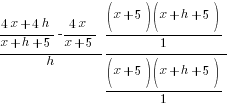 |
 |
|
 |
|
 |
|
 |
|
 |
Difference Quotient: Rational Function
Example: Find the difference quotient for 
The Difference Quotient:
Solution:
 |
|
| Write the difference quotient for the given function |  |
| Simplify the complex fraction by multiplying the numerator and denominator by the common denominator | 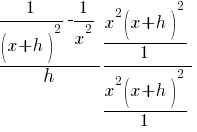 |
| Distribute the common denominator to each fraction in the numerator. |  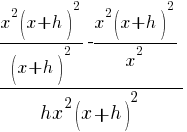 |
  |
|
  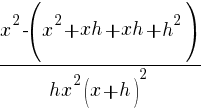 |
|
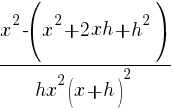  |
|
 |
|
 |
The difference quotient for  is
is 
Application: Quadratic Equation (Position Equation)
Application: Quadratic Equation (Pythagorean Theorem)
Powers of i
Example: Simplify the power of i.

Solution:

Rewrite the exponential expression with negative exponents by using the reciprocal property.
=
Simplify the  by dividing 59 by 4. The remainder will tell you which position in the pattern you are in. 59 divided by 4 is 14 with a reminder of 3.
by dividing 59 by 4. The remainder will tell you which position in the pattern you are in. 59 divided by 4 is 14 with a reminder of 3.
=
=
=
=
=
=
=
Consecutive Numbers
Here is a handout about consecutive numbers.
Translating Phrases
Here is a handout on translating phrases from words into mathematical expressions and equations. Solutions are provided on last page.
Graphing an Exponential Equation by Transformations
Example: For the function below. Graph using transformations. Find the y-intercept. State the horizontal asymptote and the domain and range.

First we must examine the base function 
Graph using plotting points. We can use the standard set of x-values to find ordered pairs.
| x | y |
|---|---|
| -2 | 2^(-2)=1/4 |
| -1 | 2^(-1)=1/2 |
| 0 | 2^0=1 |
| 1 | 2^1=2 |
| 2 | 2^2=4 |
The graph below shows the points plotted and the line that connects them. This graph has a horizontal asymptote at y=0. The domain is  and the range is
and the range is 

Analyze the transformations.

The +2 in the exponent shifts the graph left 2 units.
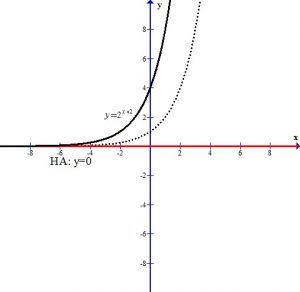
The – in the front of the base reflects the graph over the x-axis.
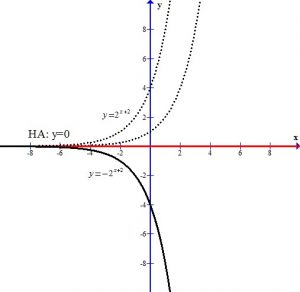
The +2 next to the base shifts the graph and the horizontal asymptote up two units.
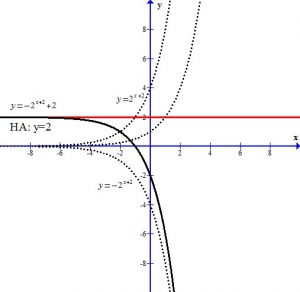
You can see the graph after the transformations.
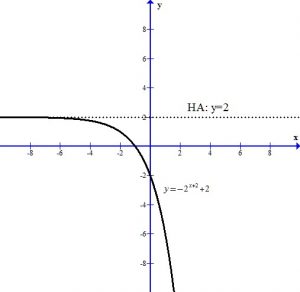
The horizontal asymptote is y=2. The domain is  and the range is
and the range is 
To find the y-intercept we let x=0.





Thus the y-intercept is (0,-2)
Here is a youtube video with examples.
Quadratic Function: General Form
Example: Rewrite the given quadratic function in standard form by completing the square. Then state the domain, range, vertex, x-intercepts, y-intercept, the orientation (opens up or opens down), and the axis of symmetry. Finally graph the function.

Solution:
Rewrite function in standard form.




Here is a youTube video that demonstrations the process.
Find the vertex.
When the quadratic function is written in standard form you can identify the vertex as (h,k).


The vertex of the quadratic function is  .
.
Find the orientation.
The leading coefficient of the quadratic function is negative so the parabola opens down.
Find the y-intercept.
To find a y-intercept let x=0.




The y-intercept is (0,8).
Find the x-intercept.
To find an x-intercept let y=0 or f(x)=0.









 or
or 
 or
or 
Find the axis of symmetry.
The axis of symmetry is a vertical line that passes through the vertex. Since the vertex is  the axis of symmetry is
the axis of symmetry is  .
.
Graph the function.
Plot the intercepts and the vertex.
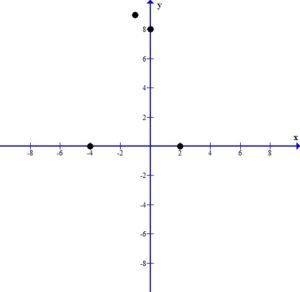
Since the vertex is the highest point we can draw the parabola using the peak at the vertex.
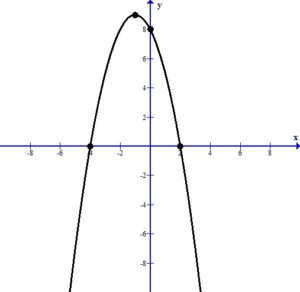
Find the domain and range.
The domain is  .
.
The range is 
![- infty, 9 {}{]} - infty, 9 {}{]}](http://math15fun.com/wp-content/plugins/wpmathpub/phpmathpublisher/img/math_981_cf307bba3f49c962fc8d40a950c676b1.png) .
.
Here a few video examples of analyzing the graph in general form.